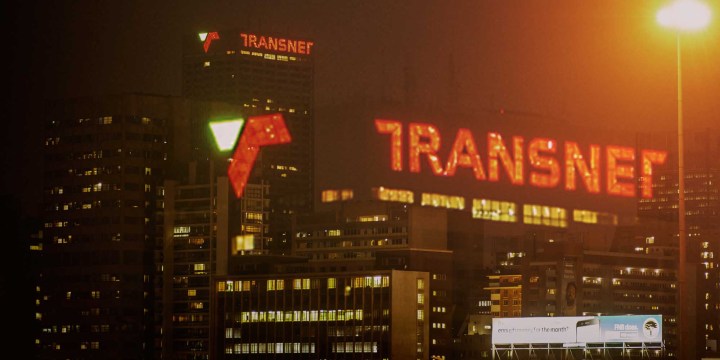BUSINESS MAVERICK OP-ED
Further credit ratings downgrades pose a risk to Transnet

The good, the bad and the ugly of S&P Global Ratings’ assessment of the state-owned logistics company.
Environmental factors remain fluid and are a risk factor to Transnet’s financial sustainability. On the upside, the new leadership at Transnet has infused a new organisational culture that prioritises governance and sets the company on a better footing. However, the after-effects of State Capture and recessionary conditions linger, while Covid-19 lurks.
The economic headache spawned by Covid-19 has exposed pre-existing underlying risks among some businesses, while reinforcing the sound fundamentals of others. In terms of state-owned entities, Transnet falls somewhere at the midpoint of these two dynamics, according to the latest assessment of the company by credit ratings agency S&P Global Ratings.
In October, the state-owned integrated logistics company released its results, showing a credible, but not particularly spectacular performance for the financial year that ended on 31 March 2020. The official statement couched the results as “solid”.
That is fair enough when taking into account how in recent years Transnet has been mired in State Capture controversy and its internal governance has been less than stellar. This was most apparent in the quantum of irregular expenditure documented in the 2019 financial year. A deterioration in its governance correlated robustly with weakened operational performance in some segments, endemic low morale throughout the group and less than adequate procurement controls.
In the 2020 financial year, revenue increased by a modest 1.3% to R75.1-billion. In 2019, revenue improved by 1.6% to R74.1-billion. An important distinction has to be drawn between the 2019 and the 2020 revenue growth. The former was driven by operational factors, while the latter was pushed up by a price increase – or an upward tariff adjustment.
The company states: “Transnet reported an increase… in revenue, supported by the weighted average tariff increase of 2.9%. The revenue increase was offset by a decline of 1.3% in rail freight volumes, and a volume decrease of 2.4% in port container throughput… compared with the prior year.”
This reality is reflected in the company’s bottom line, which has contracted substantially.
In 2020, profit dropped by a drastic 34.9% to R3.9-billion. In 2019, Transnet posted a R6-billion profit, representing a 24.7% improvement. In addition, the company’s gearing in 2019 was 44.5% compared with 47.6% in 2020. That 3.1 percentage points difference might not seem like much, but it is quite significant given the current macroeconomic environment uncertainties that are attributable to the volatility sparked by Covid-19.
In simple terms, the 2020 results do not fully encompass the realities of the coronavirus outbreak with reference to Transnet’s operational performance. That will become clearer when the company presents its 2021 results. As such, it can be argued that the 2020 results are demonstrative of the recessionary conditions South Africa was in prior to Covid-19 being the factor it is at present.
But … [in] our assessment of Transnet’s standalone credit profile… we consider Transnet’s less than adequate liquidity… the high amount of debt subject to varied and complex covenants, which is uncommon for similarly rated peers, as well as the covenants’ potential to further affect liquidity.
In fact, S&P projects that in 2021 Transnet’s revenue will drop by 10%, “followed by a modest recovery in 2022”. The credit ratings agency cites Covid-19 as a constraining factor to Transnet’s ability to generate revenue.
Therefore, “Transnet’s liquidity remains less than adequate, in our view, and we believe there is a possibility it will breach financial and/or ratings-related covenants in the next six months,” cautions S&P Global Ratings.
Therein lies the significance of the 2020 gearing ratio. But Transnet does point out in its 2020 results that the 47.6% gearing is “within loan covenant requirements”.
In its risk report, which accompanied the 2020 results announcement, Transnet lists financial sustainability, macroeconomic risk, market growth and people among its top risks.
The company references as reasons for a heightened financial sustainability risk: market liquidity, lower economic growth rates, both domestically and globally, which will affect revenue generation, and the global logistic chain disruptions because of Covid-19. Furthermore, Transnet cites “elevated credit exposure due to customer payment defaults” for pushing up the financial stability risk.
Added to that are “credit ratings agencies’ assessments and their impact on the company’s funding requirements”, which pose “refinancing risks”.
The company expands further on risks pertaining to the macroeconomic environment, market growth and people risk. The 20-page risk report is worth a read because it is a frank self-assessment and gives insights into the new leadership’s priorities. Most important, the company articulates how it plans on mitigating its key risk factors.
S&P does take that into consideration in its review of Transnet. The agency has affirmed the company’s BB- rating, while maintaining the state-owned logistics entity’s outlook as stable.
But, “… [in] our assessment of Transnet’s standalone credit profile… we consider Transnet’s less than adequate liquidity… the high amount of debt subject to varied and complex covenants, which is uncommon for similarly rated peers, as well as the covenants’ potential to further affect liquidity”.
In that regard, S&P “continues to see risk to Transnet’s [standalone credit profile]… stemming from further liquidity stress, including the impact of potential unremediated breaches of financial and rating-related covenants – covenants with a minimum rating requirement”.
In plain language, that means Transnet is at risk of further credit ratings downgrades.
From a value perspective, such a scenario will have an adverse effect on Transnet’s financial results, according to the company. That would factor all of the variables contributing to the increased risks to financial sustainability, which are listed in Transnet’s 2020 risk report. BM/DM

















 Become an Insider
Become an Insider
Comments - Please login in order to comment.